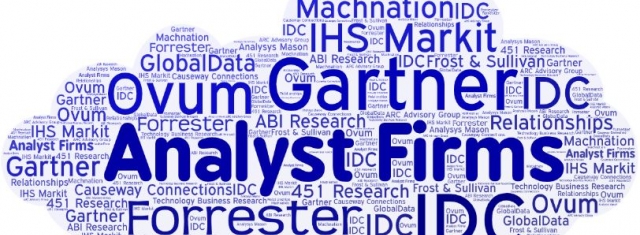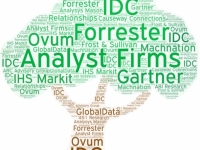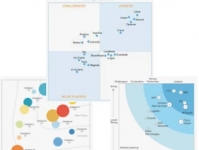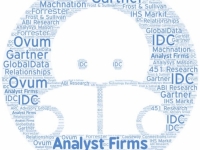Technology
Analyst Relations (AR) - Do you know what to do and what not to do?
Find out what NOT to do!

Industry Analyst Relations can sometime be cloudy (Source: Peter Granger Creative)
USPA NEWS -
Peter Granger provides insight into what works with High-Tech Industry Analysts and what doesn´t.
In this article Peter's experience can help companies navigate their relationship with key industry analysts. It isn't always easy, but there are some useful hints and tips to help you steer the relationship if you are a vendor.
Peter urges you to engage positively. These analysts are not to be feared but to be embraced.
Ignore them at your peril!
In this article Peter's experience can help companies navigate their relationship with key industry analysts. It isn't always easy, but there are some useful hints and tips to help you steer the relationship if you are a vendor.
Peter urges you to engage positively. These analysts are not to be feared but to be embraced.
Ignore them at your peril!
Industry Analyst Relations ““ Introduction
The high-tech world relies on analysts to “˜keep them honest´ when it comes to assessing a vendor´s standing in the marketplace. It´s no secret that the “˜Big Three´ are influential in terms of vendor choice, measuring companies´ abilities to provide solutions to customer´s technical and business problems. You'll likely know who the 'Big Three' are - if not I'll be covering that below!Whether they are Leaders, Challengers, Visionaries, or Niche Players in Gartner´s Magic Quadrant; or perhaps Leaders, Major Players, Contenders, or simply Participants in IDC´s MarketScape; or even Leaders, Strong Performers, Contenders or Challengers in a ForresterWave, companies including high-tech firms strive for leadership, and purchasers look to the “˜top-right´ to see who the analyst has put in the leadership category.
Some clients of analysts even go so far as requiring vendors and suppliers to be visible in one of the diagrams mentioned above before they will entertain a response to a “˜Request for Information´ (RFI), or a ´Request for Proposal´ (RFP).
That´s not to say that niche and boutique players are not influential. On the contrary, many address particular marketplaces with greater depth if a little less breadth.
How it works most of the time...
Let´s look at tech vendors and their approach to analysts. Most will have whole Analyst Relations (AR) departments devoted to dealing with analyst organizations, big or small. These groups will often have full time personnel devoted to particular market segments. They are committed to providing a professional interface for their own internal Subject Matter Experts (SMEs) to engage with the analysts. The idea is to talk to each other, analyst and vendor. Perhaps the vendor is updating the analysts on products and solutions, or asking for feedback from analysts on market potential, strategic direction or the like. The vendor might fund the relationship with the analyst firm in the case of some interactions, and arrangements vary.When things go wrong...
Having said this, there can be quite a few things that can go wrong. Some companies will, from time-to-time, pull back from analysts for a particular segment of their business. There are varied reasons for this, but often, as I have experienced myself, there is embarrassment that the vendor messaging needs work and that the company “hasn´t got its act together“ to talk with analysts. It can also be as a result of “˜Vendor Ego´ getting in the way: the vendor doesn´t like a recent review, and gets huffy with the analyst firm. It happens a lot with big companies!Now, messaging is important to get right for sure. The vendor's AR Department needs to ensure the SMEs are top-notch with their communication skills. The AR department must also overcome that “˜Vendor Ego´ I mentioned, such that lines of communication with the analyst firms are not compromised. However, none of these are reasons to disengage.
So, what should vendors be doing? Here are some Hints and Tips“¦.
DO NOT PULL AWAY...
If you “˜go-dark´, as it were, the analyst firms will assume the worst, especially if the previous relationship was open. I have seen this several times. There are easy ways to address this. If going through a re-organization such that SMEs may be being re-deployed, maintain an open relationship. Focus conversations on the three things analysts are interested in:a) Customer references and case studies (assuming you have them). Include Customer Business Outcomes, timelines and competitive differentiation.
b) Your strategy for proposed future developments including road maps and financials (if available) along with unique
differentiators such as, patents, partnerships, etc.
c) Invitation to the analyst firm to provide feedback and consultancy. This will require funding for the most part and
provide either validation of strategy, or areas that need attention. Analyst firms become vested and more likely to
engage when their services are “˜fee´ rather than “˜free´.
DO NOT RESPOND TO EVERY SURVEY...
Despite the advice above, be selective in responding to an analyst firm´s invitation to partake in a survey where you will be compared with perceived peers. Here are a couple of things to consider:DO NOT IGNORE YOUR ANALYSTS...
Remember that analysts´ clients are likely your customers. If you don´t nurture the relationships your competitors will. The messages that go to your customer will include your competitors messaging, not yours.a) Integrate your marketing and AR. If you´re unsure when, research when the analyst firm will be executing some relevant research, either new or refreshment of old research. Book some time with the firm, pay the daily fee or similar, work with the analyst sharing your best execs, SMES, plans, strategies and references in relation to that research. Including a customer or two in the discussion is exponentially helpful if the customer is properly selected and briefed beforehand.
b) Listen to the analyst. Take the analyst´s advice. Demonstrate you´ve done this with follow-ups and plan for future consultancy business for the analyst, letting them know your intent, planning the timing to just before the relevant piece of research commences. These firms are generally not “˜pay-to-play´; however, I´ve followed my advice above successfully in the past, obtaining Leadership in the most far top-right for my tech-company by paying to educate and validate, not to influence.
Firstly, carefully weigh the value versus the risk. Remember many analyst clients are your customers. As mentioned above, you may be excluded from potential RFPs if you are not anywhere on a Quadrant, Wave, or a Scape. On the other hand, there will be reticence by your senior management to be in the “˜lower left´ of the survey. Make a decision you´re comfortable with...
Secondly, if you decide not to partake (and there will always be dubious research requests from dubious firms that make that the right decision), plan to review with a positive response the following year. You´ll be moving from a nobody to at least a somebody that next year.
Recognize that analyst firms have different value propositions...
“¢ Gartner is clearly the 400-pound gorilla. They have strong influence in the tech world, and their “˜Hype-Cycle´ helps predict the future. Their proprietary methodology means their view of a vendors Completeness of Vision and Ability to Execute are generally impartially accurate.“¢ Forrester is a little less influential but many of their clients (end customers and vendors) value their SWOT analysis and Industry analysis.
“¢ IDC is strong on market numbers, and many of their clients see them as the go-to firm for market shares and future market grow assessments.
“¢ Other smaller firms, including niche and boutique players, can offer specific targeted research to clients and shouldn´t be ignored when budgeting. They include 451 Research, Ovum, Frost and Sullivan, GlobalData, MachNation and Causeway Connections for the Internet of Things (IoT) for example.
Summary and Conclusions
In summary, the worse thing you can do is ignore the analyst community. That lack of communication can take years to recover from, with vendor companies “˜moving on´ executives that do not perform well with analysts or analyst firms.As we come out of the worst of the COVID world and a new administration takes the wheel in the United States in 2021, the recovery opportunity will be spurred on by the research and market information that these analysts can provide.
Get ready for it!
Disclosure
Peter Granger has been working with analysts for over ten years. He has worked in executive positions at IBM and Sun Microsystems (pre-Oracle acquisition), and consulted as Senior AR Manager for IoT for Cisco Systems.
Abi Research Analysys Mason 451 Research Machnation Globaldata Ihs Markit Ovum Forrester Gartner Idc Technology High-tech Analyst Relations Analyst Industry Analyst
Liability for this article lies with the author, who also holds the copyright. Editorial content from USPA may be quoted on other websites as long as the quote comprises no more than 5% of the entire text, is marked as such and the source is named (via hyperlink).








